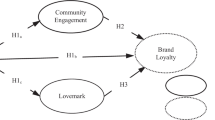Abstract
A retail sales pull factor measures how strongly a community draws consumers from outside of the community and retains its own residents for retail consumption. A high retail sales pull factor community denotes that the community is generating retail revenues while a low pull factor community indicates that the community is leaking retail revenues. This research proposes that ‘branding the downtown’ is an effective strategy to increase the community’s retail sales pull factor by comparing business owners responses to (1) perceived downtown and business performance; and (2) perceived accessibility of internal communication about downtown branding between business owners in high pull factor and low pull factor communities. One hundred and sixty-seven responses were collected from downtown business owners in small communities in a Midwestern state. Independent samples t-test results showed that downtown business owners in communities with a high pull factor evaluated the performance of their downtown and own business more favorably than those in communities with a low pull factor and perceived that internal communication about downtown branding was accessible to them. The findings suggest that community administrators should make efforts to brand their downtown areas. It is recommended that effective brand communication activities among business owners be instigated to increase positive downtown branding effects.
Similar content being viewed by others
References
Aaker, D.A. (1996) Building Strong Brands. New York: Free Press.
Anholt, S. (2005) Some important distinctions in place branding. Place Branding 1 (2): 116–121.
Anholt, S. (2008) Place branding: Is it marketing, or isn’t it? Place Branding and Public Diplomacy 4 (1): 1–6.
Ashworth, G. and Kavaratzis, M. (2007) Beyond the logo: Brand management for cities. Journal of Brand Management 16 (8): 520–531.
Asif, S. and Sargeant, A. (2000) Modeling internal communications in the financial services sector. European Journal of Marketing 34 (3/4): 299–317.
Barta, S., Trzebiatowski, S., Jones, S., Frye, J. and Woods, M. (2001) Analysis of retail trends and taxable sales for Durant, Oklahoma and Bryan County. Oklahoma Cooperative Extension Service. http://www.rd.okstate.edu/pdf/durantpf.pdf, accessed 28 June 2009.
Berenson, M.L., Levine, D.M. and Krehbiel, T.C. (2011) Basic Business Statistics: Concepts and Applications. New York: Pearson.
Boyd, G. and Sutherland, M. (2006) Obtaining employees commitment to living the brand of the organization. South African Journal of Business Management 37 (1): 9–20.
Brown, R.J. and Sorensen, B. (2007) A study of retail trade patterns in South Dakota. South Dakota Business Review 65 (4): 1–15.
Cova, B. (1996) The postmodern explained to managers: Implications for marketing. Business Horizons 39 (6): 13–23.
Csaba, F. (2005) The application of branding to non-profit organizations and places. In: M. Schultz, Y. Antorini and F. Csaba (eds.) Branding: Purpose/People/Process. Koge, Denmark: Copenhagen Business School Press.
David, G. (2011) A (tentative) meta-analysis of the ‘place marketing’ and ‘place branding’ literature. Journal of Brand Management 19 (2): 112–132.
Dennis Jr, W.J. (2003) Raising response rates in mail surveys of small business owners: Results of an experiment. Journal of Small Business Management 41 (3): 278–295.
Estrada, J.K. and Allen, A. (2001) A pull factor analysis of trends in food and beverage retail sales in Mississippi countries. Journal of Food Distribution Research 32 (1): 46–52.
Fayolle, A., Basso, O. and Bouchard, V. (2010) Three levels of culture and firms’ entrepreneurial orientation: A research agenda. Entrepreneurship & Regional Development 22 (7/8): 707–730.
Gastwirth, J.L., Gel, Y.R. and Miao, W. (2009) The impact of Levene’s test of equality of variances on statistical theory and practice. Statistical Sciences 24 (3): 343–360.
Hankinson, G. (2007) The management of destination brands: Five guiding principles based on recent developments in corporate branding theory. Journal of Brand Management 14 (3): 240–254.
Harris, T.R. and Shonkwiler, J. (1997) Interdependence of retail businesses. Growth and Change 27 (3): 520–533.
Heldt Cassel, S. (2008) Trying to the attractive: Image building and identify formation in small industrial municipalities in Sweden. Place Branding and Public Diplomacy 4 (2): 102–114.
Henkel, S., Tomczak, T., Heitmann, M. and Herrmann, A. (2007) Managing brand consistent employee behavior: Relevance and managerial control of behavioral branding. Journal of Product & Brand Management 16 (5): 310–320.
Henry, G.T. (1990) Practical Sampling. Newbury Park, CA: Sage.
Houghton, J.P. and Stevens, A. (2011) City branding and stakeholder engagement. In: K. Dinnie (ed.) City Branding: Theory and Cases. London: Palgrave Macmillan.
Johnston, N., Spinks, W. and Manning, M. (2010) Employee and customer perceptions: Their relationship to organizational performance in a franchise system. Journal of New Business Ideas and Trends 8 (1): 35–49.
Johnstone, H. and Lionais, D. (2004) Depleted communities and community business entrepreneurship: Revaluing space through place. Entrepreneurship & Regional Development 16 (3): 217–233.
Kavaratzis, M. (2004) From city marketing to city branding: Towards a theoretical framework for developing city brands. Place Branding 1 (1): 58–73.
Kemp, E., Childers, C.Y. and Williams, K.H. (2012) A tale of a musical city: Fostering self-brand connection among residents of Austin, Texas. Place Branding and Public Diplomacy 8 (2): 147–157.
King, C. and Grace, D. (2008) Internal branding: Exploring the employee’s perspective. Journal of Brand Management 15 (5): 358–372.
Klebba, J.R., Garrett, M.D., Radle, A.L. and Downes, B.T. (2001) Downtown redevelopment in selected Oregon coastal communities. In: M.A. Burayidi (ed.) Downtowns: Revitalizing the Centers of Small Urban Communities. New York, NY: Routledge, pp. 65–88.
Knox, S. and Bickerton, D. (2003) The six conventions of corporate branding. European Journal of Marketing 37 (7/8): 998–1016.
Kotler, P., Asplund, C., Rein, I. and Heider, D. (1999) Marketing Places Europe: Attracting Investments, Industries, Residents and Visitors to Europe Cities, Communities, Regions, and Nations. London: Pearson Education.
Lillis, C.M. and Hawkins, D.I. (1974) Retail expenditure flows in contiguous trade area. Journal of Retailing 50 (2): 30–42.
Mayer, V.M. (2000) The state of small cities. In: R.L. Kemp (ed.) Main Street Renewal: A Handbook for Citizens and Public Officials. Jefferson, NC: McFarland & Company.
McEachern, D. (2008) Talk from the trenches. Public Management 90 (8): 16–20.
Merrilees, B., Miller, D. and Herington, C. (2009) Antecedents of residents’ city brand attitudes. Journal of Business Research 62 (3): 362–367.
Moe, R. and Wilkie, C. (1997) Changing Places: Rebuilding Community in the Age of Sprawl. New York: Owls Books.
Nevin, J.R. and Houston, K.J. (1980) Image as a component of attraction to intraurban shopping areas. Journal of Retailing 56 (1): 77–93.
Niedomysl, T. (2004) Evaluating the effects of place marketing campaigns on interregional migration in Sweden. Environment and Planning 36 (11): 1991–2009.
Palma, D. (1998) Local officials can learn strategies for a successful downtown. Nation’s Cities Weekly, pp. 7–8.
Papadopoulos, N.G. (1980) Consumer outshopping research: Review and extension. Journal of Retailing 56 (4): 41–58.
Phillips, R. (2000) What are the positive impacts of retail-based economic growth for communities? Journal of Shopping Center Research 7 (1): 7–28.
Reilly, W.J. (1931) The Raw of Retail Gravitation. New York: Knickerbocker Press.
Reynolds, R.B. (1953) A test of the law of retail gravitation. Journal of Marketing 17 (3): 273–277.
Runyan, R.C. and Droge, C. (2008) A categorization of small retailer research streams: What does it portend for future research? Journal of Retailing 84 (1): 77–94.
Runyan, R.C. and Huddleston, P. (2006) Getting customers downtown: The role of branding achieving success for central business districts. Journal of Product and Brand Management 15 (1): 48–61.
Ryu, J.S. and Swinney, J. (2011) Downtown branding as an engine of downtown business success in small communities. Place Branding and Public Diplomacy 7 (2): 81–90.
Ryu, J.S. and Swinney, J. (2012) Aligning business owners for a successful downtown brand. Journal of Place Management and Development 5 (2): 102–118.
Stigel, J. and Frimann, S. (2006) City branding – All smoke, no fire? Nordicom Review. http://www.nordicom.gu.se/common/publ_pdf/242_stigel_frimann.pdf, accessed 28 June 2009.
Swinney, J. and Runyan, R. (2007) Native American entrepreneurs and strategic choice. Journal of Developmental Entrepreneurship 12 (3): 257–273.
Trueman, M., Klemm, M. and Giroud, A. (2004) Can a city communicate? Bradford as a corporate brand. Corporate Communications: An International Journal 9 (4): 317–330.
Vasudevan, S. (2008) The role of internal stakeholders in destination branding: Observations from Kerala tourism. Place Branding and Public Diplomacy 4 (4): 331–335.
Venkatraman, N. and Ramanujam, V. (1986) Measurement of business performance in strategy research: A comparison of approaches. Academy of Management Review 11 (4): 801–814.
Wells, B. (2003) Downtown revitalization in urban neighborhoods and small cities. Northeast Midwest Institute. http://www.nemw.org/DowntownRevital.pdf, accessed 29 April 2009.
Wernerfelt, B. (1984) A resource-based view of the firm. Strategic Management Journal 5 (2): 171–180.
Author information
Authors and Affiliations
Rights and permissions
About this article
Cite this article
Ryu, J., Swinney, J. Branding Smallville: Community place brand communication and business owner perceptions of performance in small town America. Place Brand Public Dipl 9, 98–108 (2013). https://doi.org/10.1057/pb.2013.6
Received:
Revised:
Published:
Issue Date:
DOI: https://doi.org/10.1057/pb.2013.6




